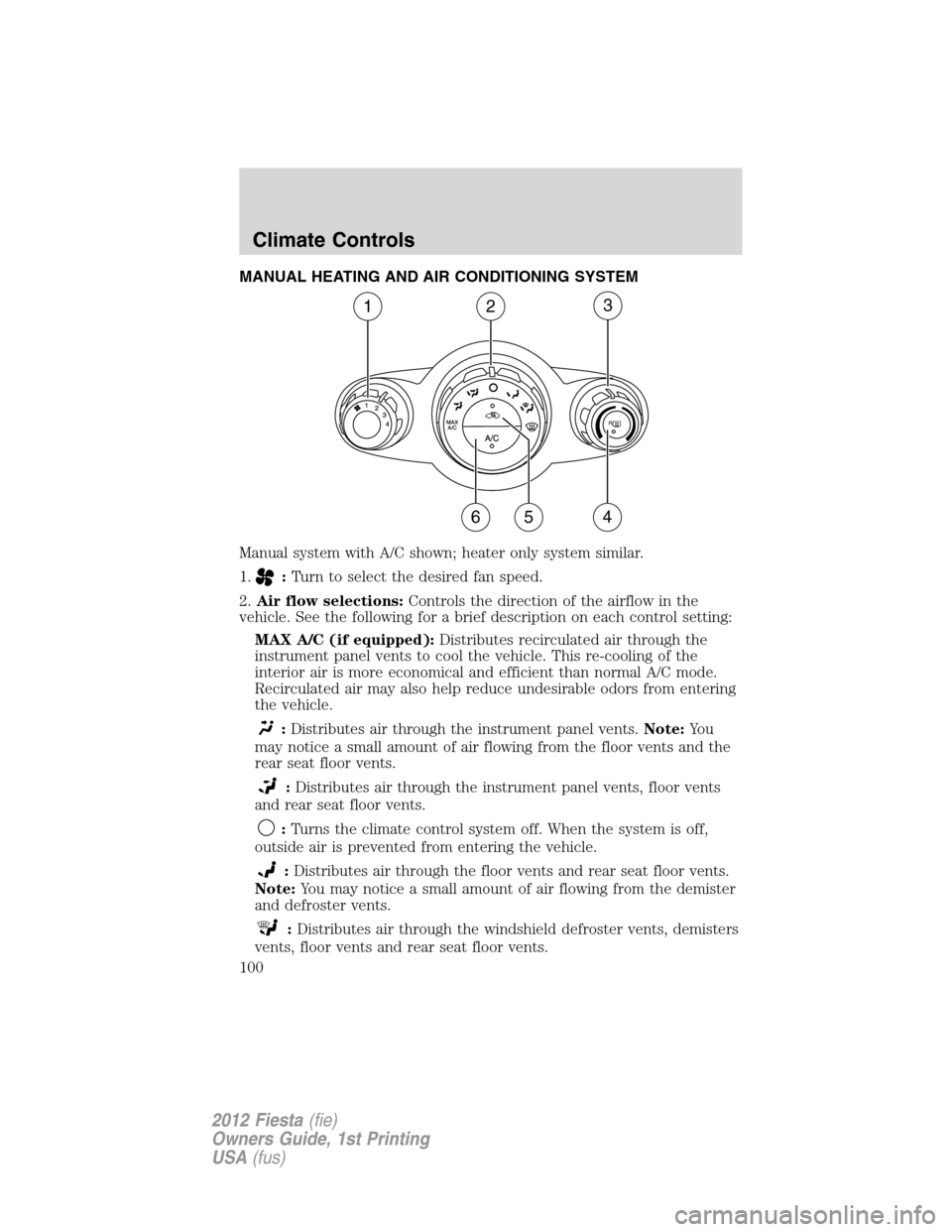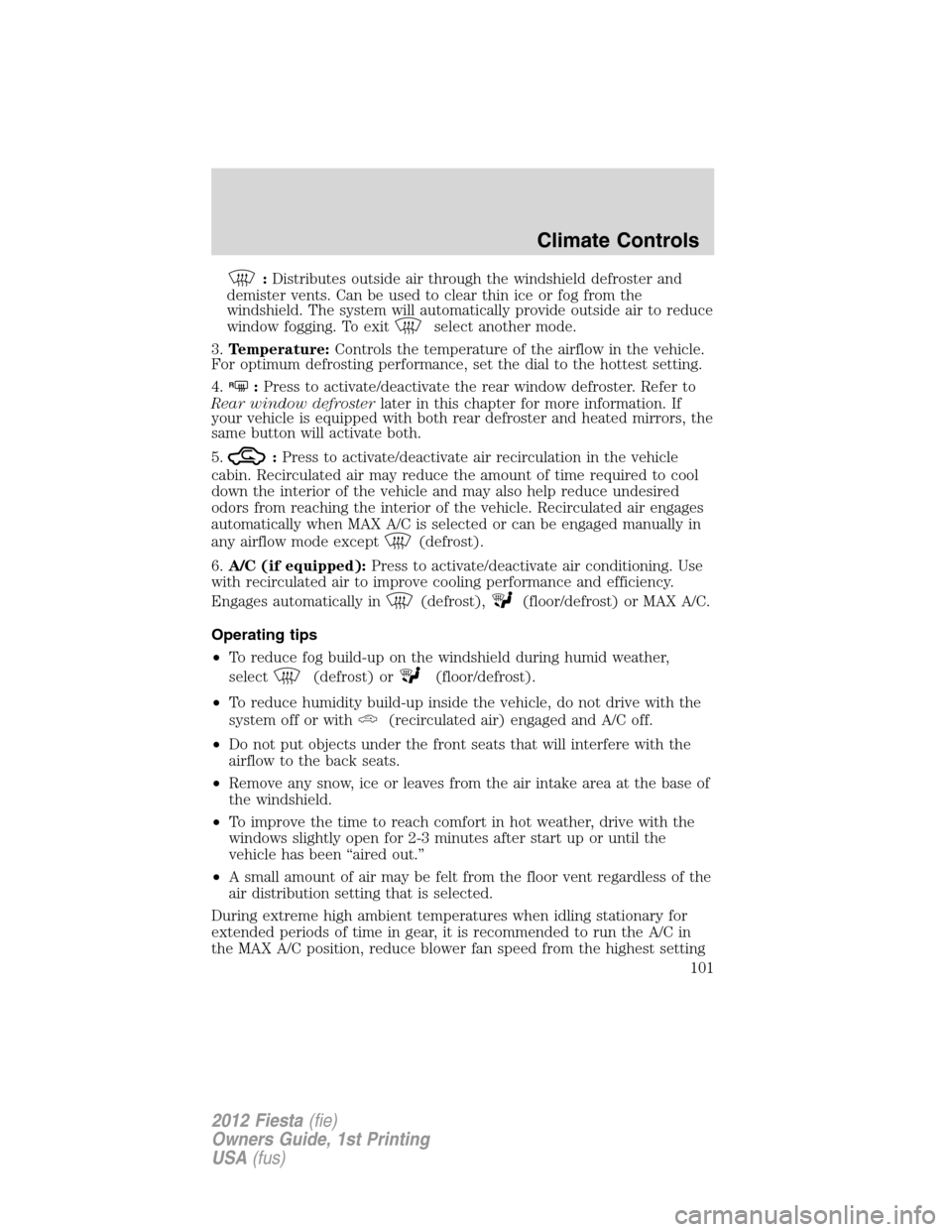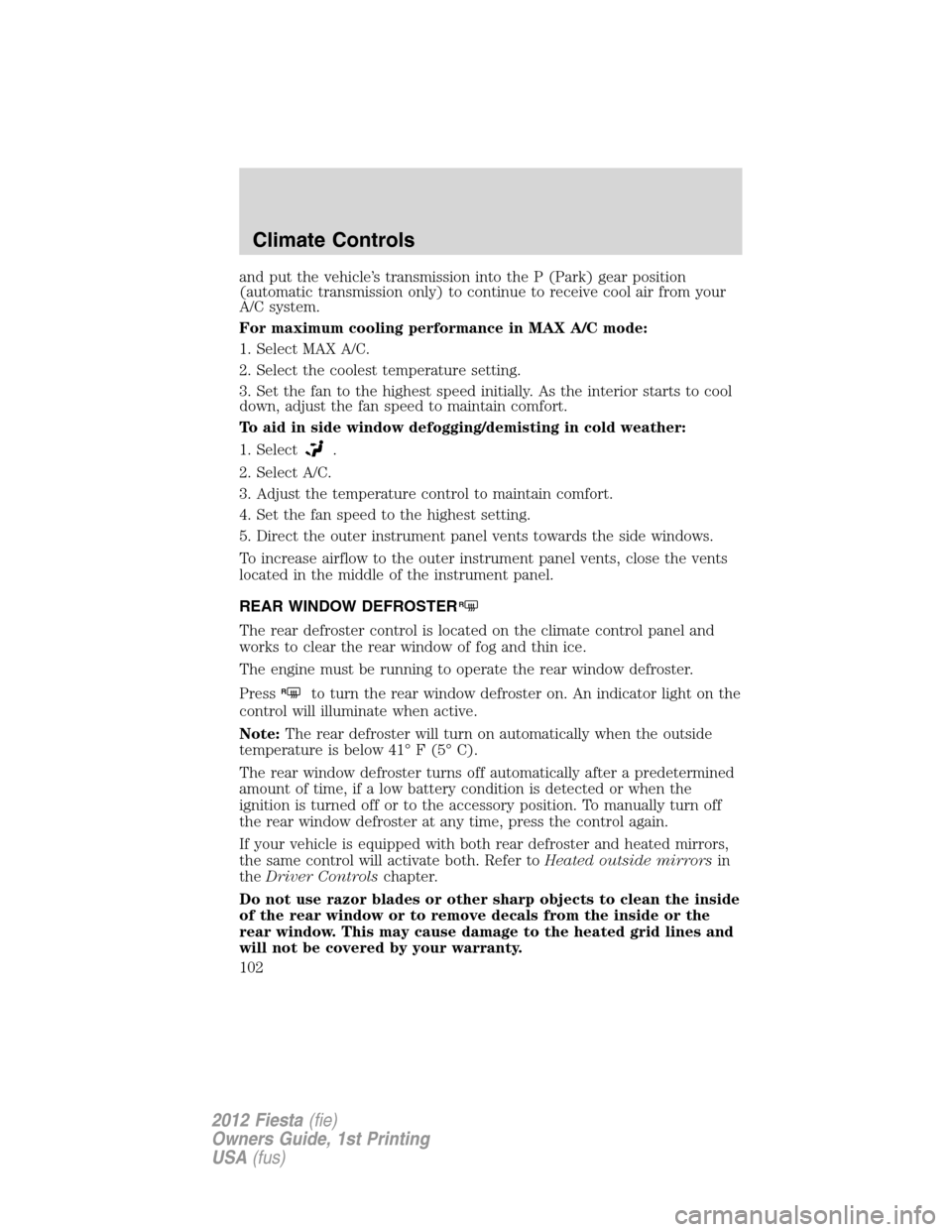2012 FORD FIESTA air condition
[x] Cancel search: air conditionPage 100 of 356

MANUAL HEATING AND AIR CONDITIONING SYSTEM
Manual system with A/C shown; heater only system similar.
1.
:Turn to select the desired fan speed.
2.Air flow selections:Controls the direction of the airflow in the
vehicle. See the following for a brief description on each control setting:
MAX A/C (if equipped):Distributes recirculated air through the
instrument panel vents to cool the vehicle. This re-cooling of the
interior air is more economical and efficient than normal A/C mode.
Recirculated air may also help reduce undesirable odors from entering
the vehicle.
:Distributes air through the instrument panel vents.Note:Yo u
may notice a small amount of air flowing from the floor vents and the
rear seat floor vents.
:Distributes air through the instrument panel vents, floor vents
and rear seat floor vents.
:Turns the climate control system off. When the system is off,
outside air is prevented from entering the vehicle.
:Distributes air through the floor vents and rear seat floor vents.
Note:You may notice a small amount of air flowing from the demister
and defroster vents.
:Distributes air through the windshield defroster vents, demisters
vents, floor vents and rear seat floor vents.
R
132
645
Climate Controls
100
2012 Fiesta(fie)
Owners Guide, 1st Printing
USA(fus)
Page 101 of 356

:Distributes outside air through the windshield defroster and
demister vents. Can be used to clear thin ice or fog from the
windshield. The system will automatically provide outside air to reduce
window fogging. To exit
select another mode.
3.Temperature:Controls the temperature of the airflow in the vehicle.
For optimum defrosting performance, set the dial to the hottest setting.
4.
R:Press to activate/deactivate the rear window defroster. Refer to
Rear window defrosterlater in this chapter for more information. If
your vehicle is equipped with both rear defroster and heated mirrors, the
same button will activate both.
5.
:Press to activate/deactivate air recirculation in the vehicle
cabin. Recirculated air may reduce the amount of time required to cool
down the interior of the vehicle and may also help reduce undesired
odors from reaching the interior of the vehicle. Recirculated air engages
automatically when MAX A/C is selected or can be engaged manually in
any airflow mode except
(defrost).
6.A/C (if equipped):Press to activate/deactivate air conditioning. Use
with recirculated air to improve cooling performance and efficiency.
Engages automatically in
(defrost),(floor/defrost) or MAX A/C.
Operating tips
•To reduce fog build-up on the windshield during humid weather,
select
(defrost) or(floor/defrost).
•To reduce humidity build-up inside the vehicle, do not drive with the
system off or with
(recirculated air) engaged and A/C off.
•Do not put objects under the front seats that will interfere with the
airflow to the back seats.
•Remove any snow, ice or leaves from the air intake area at the base of
the windshield.
•To improve the time to reach comfort in hot weather, drive with the
windows slightly open for 2-3 minutes after start up or until the
vehicle has been “aired out.”
•A small amount of air may be felt from the floor vent regardless of the
air distribution setting that is selected.
During extreme high ambient temperatures when idling stationary for
extended periods of time in gear, it is recommended to run the A/C in
the MAX A/C position, reduce blower fan speed from the highest setting
Climate Controls
101
2012 Fiesta(fie)
Owners Guide, 1st Printing
USA(fus)
Page 102 of 356

and put the vehicle’s transmission into the P (Park) gear position
(automatic transmission only) to continue to receive cool air from your
A/C system.
For maximum cooling performance in MAX A/C mode:
1. Select MAX A/C.
2. Select the coolest temperature setting.
3. Set the fan to the highest speed initially. As the interior starts to cool
down, adjust the fan speed to maintain comfort.
To aid in side window defogging/demisting in cold weather:
1. Select
.
2. Select A/C.
3. Adjust the temperature control to maintain comfort.
4. Set the fan speed to the highest setting.
5. Direct the outer instrument panel vents towards the side windows.
To increase airflow to the outer instrument panel vents, close the vents
located in the middle of the instrument panel.
REAR WINDOW DEFROSTER
R
The rear defroster control is located on the climate control panel and
works to clear the rear window of fog and thin ice.
The engine must be running to operate the rear window defroster.
Press
Rto turn the rear window defroster on. An indicator light on the
control will illuminate when active.
Note:The rear defroster will turn on automatically when the outside
temperature is below 41° F (5° C).
The rear window defroster turns off automatically after a predetermined
amount of time, if a low battery condition is detected or when the
ignition is turned off or to the accessory position. To manually turn off
the rear window defroster at any time, press the control again.
If your vehicle is equipped with both rear defroster and heated mirrors,
the same control will activate both. Refer toHeated outside mirrorsin
theDriver Controlschapter.
Do not use razor blades or other sharp objects to clean the inside
of the rear window or to remove decals from the inside or the
rear window. This may cause damage to the heated grid lines and
will not be covered by your warranty.
Climate Controls
102
2012 Fiesta(fie)
Owners Guide, 1st Printing
USA(fus)
Page 109 of 356

BULB REPLACEMENT
Lamp assembly condensation
Exterior lamps are vented to accommodate normal changes in pressure.
Condensation can be a natural by-product of this design. When moist air
enters the lamp assembly through the vents, there is a possibility that
condensation can occur when the temperature is cold. When normal
condensation occurs, a thin film of mist can form on the interior of the
lens. The thin mist eventually clears and exits through the vents during
normal operation. Clearing time may take as long as 48 hours under dry
weather conditions.
Examples of acceptable condensation are:
•Presence of thin mist (no streaks, drip marks or droplets)
•Fine mist covers less than 50% of the lens
Examples of unacceptable moisture (usually caused by a lamp water
leak) are:
•Water puddle inside the lamp
•Large water droplets, drip marks or streaks present on the interior of
the lens
Take your vehicle to a dealer for service if any of the above conditions of
unacceptable moisture are present.
Using the right bulbs
Replacement bulbs are specified in the chart below. Headlamp bulbs must
be marked with an authorized “D.O.T.” for North America and an “E” for
Europe to ensure lamp performance, light brightness and pattern and safe
visibility. The correct bulbs will not damage the lamp assembly or void the
lamp assembly warranty and will provide quality bulb burn time.
Function Number of bulbs Trade number
Headlamp (low beam) 1 H11B
Headlamp (high beam) 1 HB3-9005LL
Headlamp (park/turn) 1 3157NAK
(amber)
Headlamp (side marker) 1 168
4-door rear bodyside lamp
(park/turn/sidemarker)1 3157K
4-door rear deck lamp
(backup)1 921
Lights
109
2012 Fiesta(fie)
Owners Guide, 1st Printing
USA(fus)
Page 154 of 356

3. Stow the safety belt in the belt
stowage clip. This will prevent the
safety belt from getting caught in
the seat latch.
When raising the seatback(s), make sure you hear the seat latch into place.
WARNING:Before returning the seatback to its original
position, make sure that cargo or any objects are not trapped
behind the seatback. Make sure that the safety belt is not laying on the
seat latch. After returning the seatback to its original position, pull on
the seatback to ensure that it has fully latched. An unlatched seat may
become dangerous in the event of a sudden stop or collision.
PERSONAL SAFETY SYSTEM™
The Personal Safety System provides an improved overall level of frontal
crash protection to front seat occupants and is designed to help further
reduce the risk of airbag-related injuries. The system is able to analyze
different occupant conditions and crash severity before activating the
appropriate safety devices to help better protect a range of occupants in
a variety of frontal crash situations.
Your vehicle’s Personal Safety System consists of:
•Driver and passenger dual-stage airbag supplemental restraints.
•Front safety belts with pretensioners, energy management retractors,
and safety belt usage sensors.
Seating and Safety Restraints
154
2012 Fiesta(fie)
Owners Guide, 1st Printing
USA(fus)
Page 155 of 356

•Driver’s seat position sensor.
•Front crash severity sensor.
•Front passenger sensing system.
•“Passenger airbag off” or “pass airbag off” indicator lamp.
•Restraints Control Module (RCM) with impact and safing sensors.
•Restraint system warning light and back-up tone.
•The electrical wiring for the airbags, crash sensor(s), safety belt
pretensioners, front safety belt usage sensors, driver seat position
sensor, and indicator lights.
How does the Personal Safety System work?
The Personal Safety System can adapt the deployment strategy of your
vehicle’s safety devices according to crash severity and conditions. A
collection of crash sensors provides information to the Restraints Control
Module (RCM). During a crash, the RCM may activate the safety belt
pretensioners and/or either none, one, or both stages of the dual-stage
airbag supplemental restraints based on crash severity and conditions.
The fact that the pretensioners or airbags did not activate for both front
seat occupants in a collision does not mean that something is wrong with
the system. Rather, it means the Personal Safety System determined the
accident conditions (crash severity, belt usage, etc.) were not
appropriate to activate these safety devices. Front airbags are designed
to activate only in frontal and near-frontal collisions, not rollovers,
side-impacts, or rear-impacts unless the collision causes sufficient
longitudinal deceleration.
Driver and passenger dual-stage airbag supplemental restraints
The dual-stage airbags offer the capability to tailor the level of airbag
inflation energy. A lower, less forceful energy level is provided for more
common, moderate-severity impacts. A higher energy level is used for
the most severe impacts. Refer toAirbag supplemental restraints
(SRS)section in this chapter.
Front crash severity sensor
The front crash severity sensor enhances the ability to detect the
severity of an impact. Positioned up front, it provides valuable
information early in the crash event on the severity of the impact. This
allows your Personal Safety System to distinguish between different
levels of crash severity and modify the deployment strategy of the
dual-stage airbags and safety belt pretensioners.
Seating and Safety Restraints
155
2012 Fiesta(fie)
Owners Guide, 1st Printing
USA(fus)
Page 157 of 356

Front safety belt usage sensors
The front safety belt usage sensors detect whether or not the driver and
front outboard passenger safety belts are fastened. This information
allows your Personal Safety System to tailor the airbag deployment and
safety belt pretensioner activation depending upon safety belt usage.
Front outboard safety belt pretensioners
The safety belt pretensioners at the front outboard seating positions are
designed to tighten the safety belts firmly against the occupant’s body
during frontal collisions, and in side collisions when the side air curtain
system activates. This helps increase the effectiveness of the safety belts.
In frontal collisions, the safety belt pretensioners can be activated alone
or, if the collision is of sufficient severity, together with the front airbags.
Front outboard safety belt energy management retractors
The front safety belt energy management retractors allow webbing to be
pulled out of the retractor in a gradual and controlled manner in
response to the occupant’s forward momentum. This helps reduce the
risk of force-related injuries to the occupant’s chest by limiting the load
on the occupant.
Determining if the Personal Safety System is operational
The Personal Safety System uses a warning light in the instrument
cluster or a backup tone to indicate the condition of the system. Refer to
theWarning lights and chimessection in theInstrument Cluster
chapter. Routine maintenance of the Personal Safety System is not
required.
The Restraints Control Module (RCM) monitors its own internal circuits
and the circuits for the airbag supplemental restraints, crash sensor(s),
safety belt pretensioners, front safety belt buckle sensors, front
passenger sensing system, and the driver seat position sensor. In
addition, the RCM also monitors the restraints warning light in the
instrument cluster. A difficulty with the system is indicated by one or
more of the following.
•The warning light will either flash or stay lit.
•The warning light will not illuminate immediately after ignition is
turned on.
•A series of five beeps will be heard. The tone pattern will repeat
periodically until the problem and warning light are repaired.
If any of these things happen, even intermittently, have the Personal
Safety System serviced at an authorized dealer immediately. Unless
serviced, the system may not function properly in the event of a
collision.
Seating and Safety Restraints
157
2012 Fiesta(fie)
Owners Guide, 1st Printing
USA(fus)
Page 172 of 356

•a readiness light and tone
•and the electrical wiring which connects the components
•Side curtain airbag system. Refer toSide curtain airbag systemlater
in this chapter.
•Front passenger sensing system. Refer toFront passenger sensing
systemlater in this chapter.
•“Passenger airbag off” or “pass airbag off” indicator lamp. Refer to
Front passenger sensing systemlater in this chapter.
•Driver’s side knee airbag module.
The diagnostic module monitors its own internal circuits and the
supplemental airbag electrical system wiring (including the impact
sensors), the system wiring, the airbag system readiness light, the airbag
backup power, the airbag ignitors and safety belt pretensioners.
Knee airbag system (driver’s side only)
The knee airbag is located under the instrument panel. The system
works along with the driver’s front airbag to help reduce injury to the
legs. When the driver’s airbag activates in a collision, the knee airbag
deploys from under the instrument panel.
As with front and side airbags, it is important to be properly seated and
restrained to reduce the risk of death or serious injury.
Front passenger sensing system
The front passenger sensing system is designed to meet the regulatory
requirements of Federal Motor Vehicle Safety Standard (FMVSS) 208
and is designed to disable (will not inflate) the front passenger’s frontal
airbag under certain conditions.
The front passenger sensing system works with sensors that are part of
the front passenger’s seat and safety belt. The sensors are designed to
detect the presence of a properly seated occupant and determine if the
front passenger’s frontal airbag should be enabled (may inflate) or
disabled (will not inflate).
The front passenger sensing system will disable (will not inflate) the
front passenger’s frontal airbag if:
•the front passenger seat is unoccupied, or has small/medium objects in
the front seat,
•the system determines that an infant is present in a rear-facing infant
seat that is installed according to the manufacturer’s instructions,
Seating and Safety Restraints
172
2012 Fiesta(fie)
Owners Guide, 1st Printing
USA(fus)